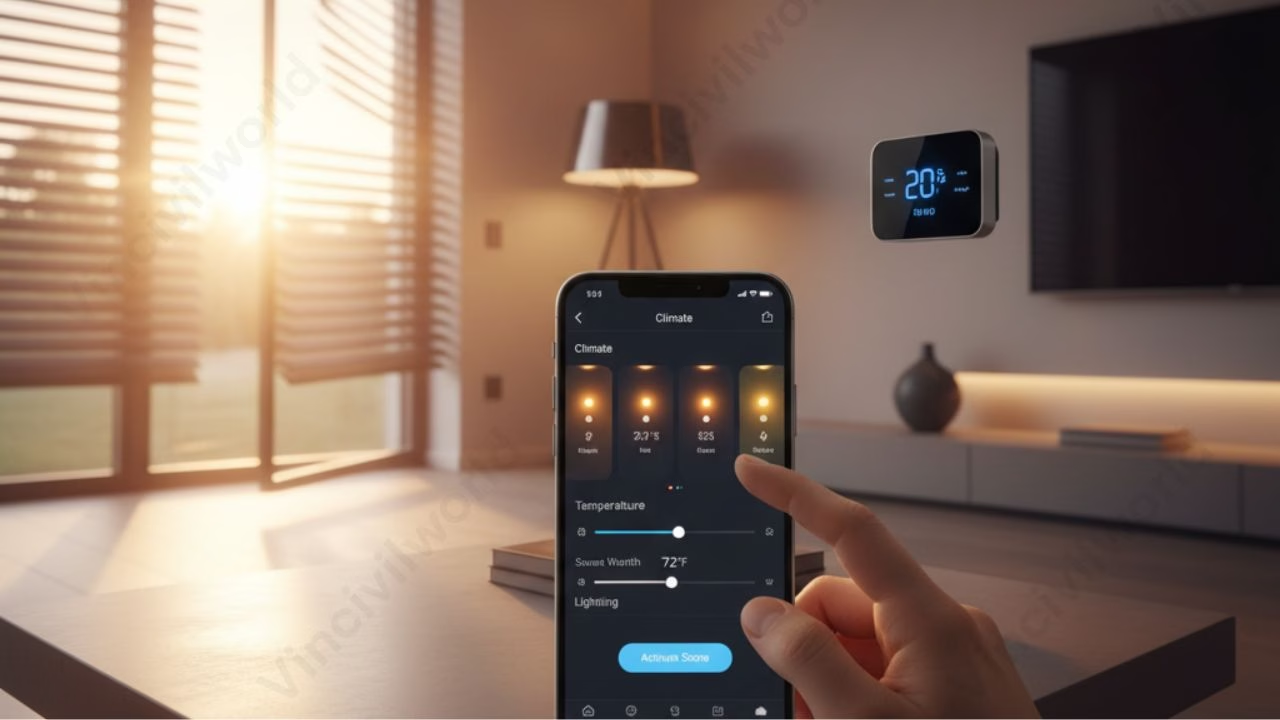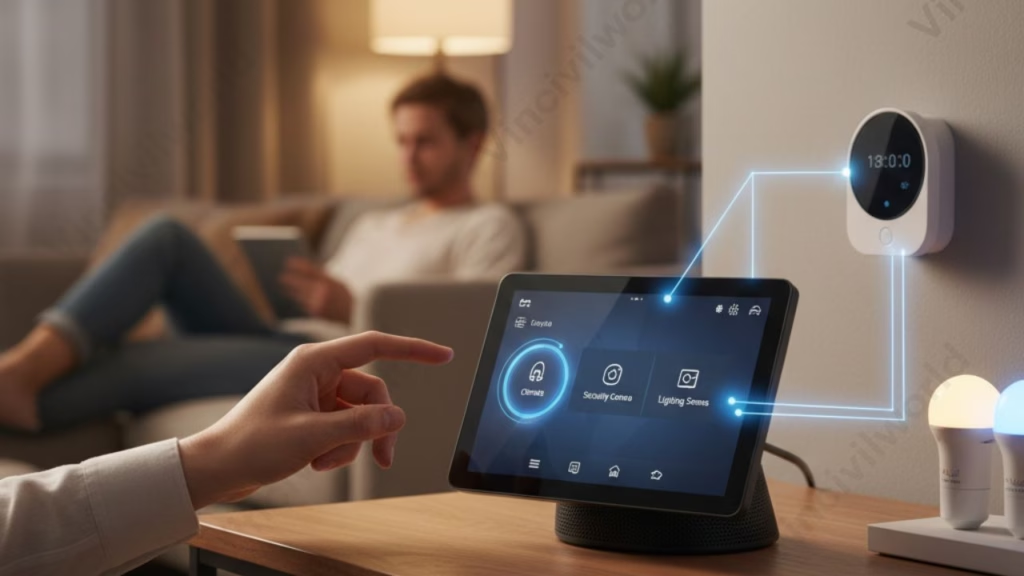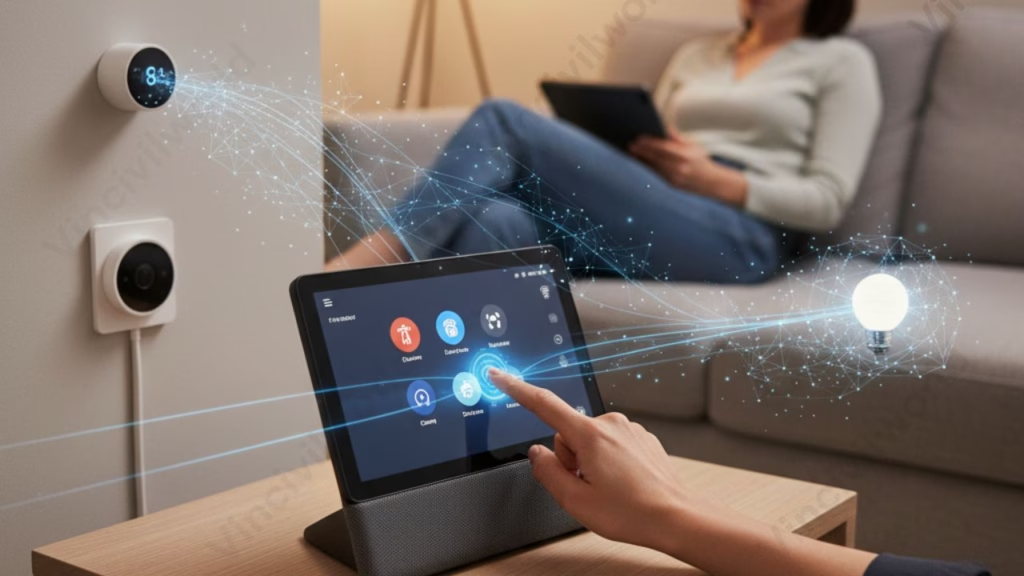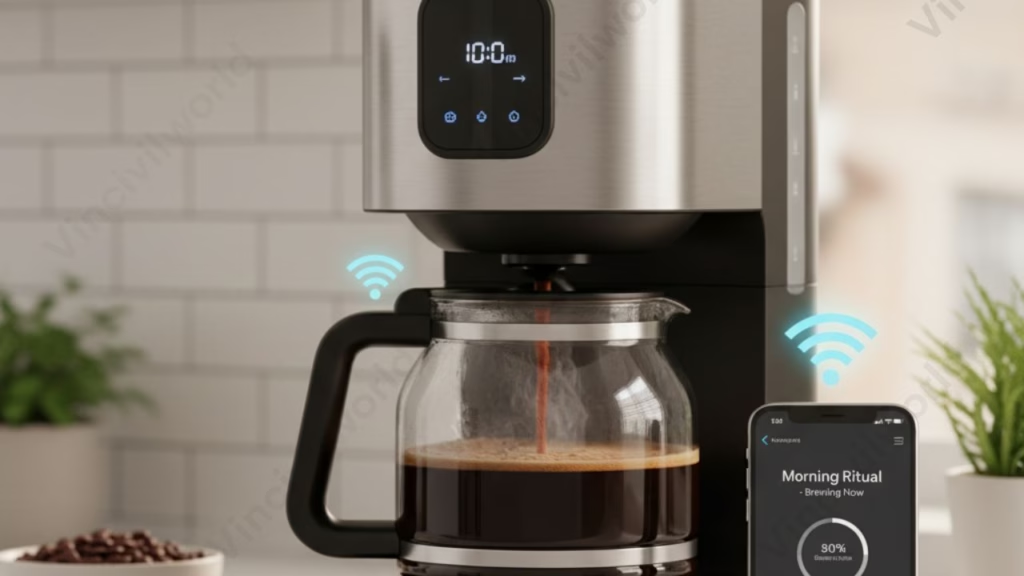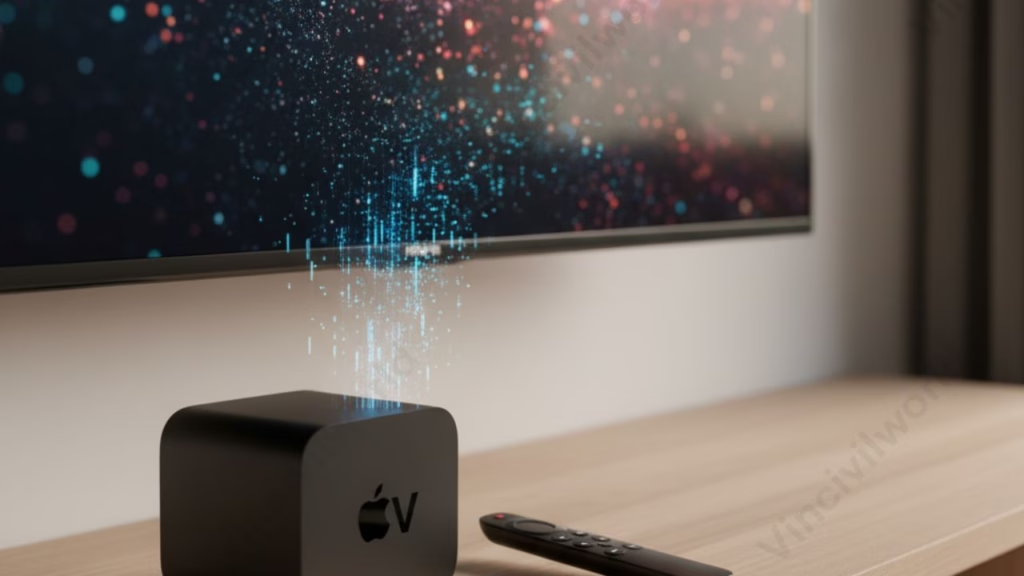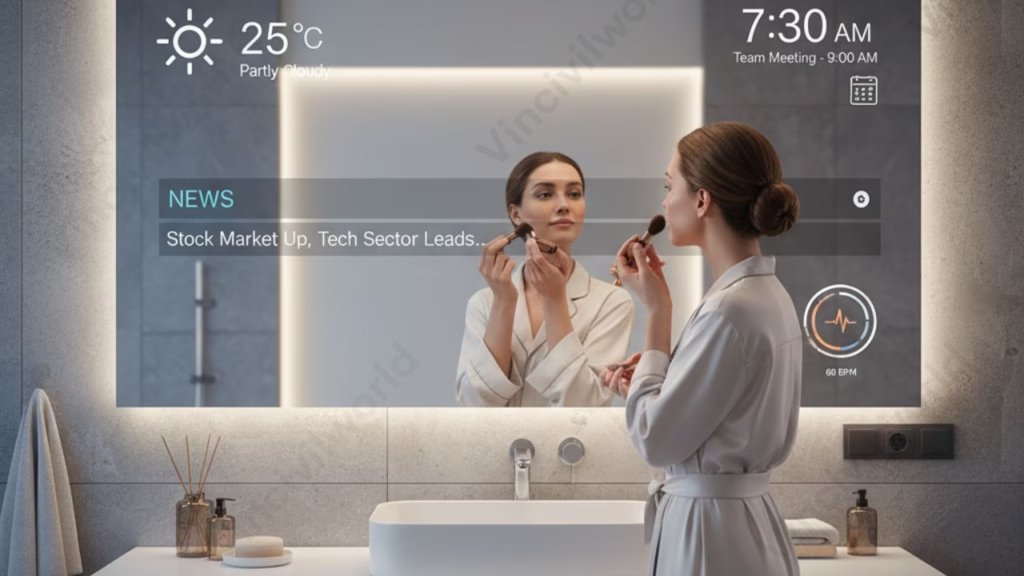Top Smart Home Gadgets & Features are rapidly transforming how we live, offering unparalleled convenience, security, and efficiency. The evolution of our homes into intelligent ecosystems is largely driven by an array of innovative smart home devices designed to simplify daily routines and enhance comfort. Among the top smart home gadgets are those that provide robust security and seamless automation. As homeowners increasingly seek ways to modernise their living spaces, understanding the best smart home technology becomes crucial. This guide will delve into the essential components that make a house truly smart. These include robust smart home security systems that offer peace of mind and advanced climate controls and entertainment hubs. We’ll explore the home automation essentials that are not just luxuries but practical solutions for a smarter, more connected lifestyle. By familiarising yourself with various smart home gadgets, you can easily navigate the exciting world of smart living.
Table of contents
The Core of Connectivity: Smart Hubs & Voice Assistants
At the heart of every truly intelligent home lies a robust system for connectivity and control, which includes some of the top gadgets in the field. This often comes in the form of smart hubs and ubiquitous voice assistants. They act as the central nervous system, allowing your diverse array of devices to communicate seamlessly. Smart hubs, such as Samsung SmartThings or Apple HomeKit, serve as a bridge for devices using different communication protocols (like Zigbee, Z-Wave, or Wi-Fi).
They translate their signals into a unified language. This ensures that your smart lock can “talk” to your smart lights, and your thermostat can “inform” your blinds, all working in concert. Without a central hub or a strong connective fabric, managing multiple brands and devices can quickly become cumbersome, necessitating the use of separate apps for each, especially when integrating top smart home gadgets.
Complementing these hubs, and often serving as a user-friendly interface for them, are voice assistants like Amazon Alexa and Google Assistant. These AI-powered entities have become indispensable. They allow users to control their entire smart home ecosystem with simple spoken commands.
From adjusting the thermostat with “Alexa, set the living room to 72 degrees” to turning off all lights with “Hey Google, goodnight,” voice assistants bring an intuitive and hands-free control experience. Many modern smart speakers, such as the Amazon Echo or Google Nest Hub, not only house these assistants. They also double as mini-hubs themselves, further simplifying the initial setup for many popular smart devices. By unifying control and enabling effortless interaction, smart hubs and voice assistants are foundational to unlocking the full potential of various smart home gadgets that sit atop innovation.
Enhanced Security: Smart Locks, Doorbells & Cameras
One of the most compelling reasons homeowners embrace smart technology is the significant enhancement it brings to security. Traditional security measures, while effective, often lack the flexibility and real-time awareness offered by modern smart gadgets. Leading this charge are smart locks, which replace conventional deadbolts with keyless entry systems. These innovative locks allow you to lock and unlock your doors remotely via a smartphone app. They also grant temporary access codes to guests or service providers and send notifications whenever someone enters or exits your home. Biometric options, like fingerprint scanners, add another layer of sophisticated protection. They eliminate the need for physical keys entirely and provide peace of mind whether you’re at work or on vacation. Amongst top smart home gadgets, smart locks certainly shine in security aspects.
Video door bells
Equally transformative are video doorbells, which offer much more than just a chime. Devices from brands like Ring and Nest provide a live video feed of your front porch, two-way audio communication with visitors, and instant motion alerts directly to your phone. This means you can see who’s at your door, speak to them, and even deter potential intruders or monitor package deliveries, all without having to open the door or even be home. Some advanced models even feature facial recognition to identify familiar visitors.
Rounding out the smart security suite are security cameras, available in both indoor and outdoor configurations. These cameras provide live streaming capabilities, record footage to cloud storage or local drives, and can be triggered by motion or sound. Modern smart cameras boast features like high-definition video, night vision, and even advanced AI detection that can differentiate between people, animals, and vehicles, reducing false alarms. Integrated smart alarm systems can link these components. They trigger sirens, flashing lights, and notify emergency services or yourself instantly in the event of a breach. Together, these smart security features create a comprehensive, vigilant shield around your home, offering unparalleled control and peace of mind through the use of various gadgets that are considered top in smart home technology.
Intelligent Lighting & Climate Control -Smart home gadgets
Beyond security, smart homes excel at creating environments that are both comfortable and energy-efficient, primarily through intelligent lighting and climate control. Smart lighting systems are a prime example of this innovation, allowing homeowners to transcend the limitations of simple on/off switches. Brands like Philips Hue and Lutron Caséta offer bulbs and fixtures that can be controlled wirelessly via apps, voice commands, or automated schedules. Imagine waking up to lights that gradually brighten like a sunrise, or arriving home to a perfectly lit entrance.
These systems enable dimming, color changes to set different moods, and even presence detection, turning lights off automatically when a room is vacant, thereby reducing electricity consumption. You can create intricate scenes for movie nights, dinner parties, or quiet evenings, all with a single tap or voice command.
Smart Thermostats
Complementing intelligent lighting are smart thermostats, which have revolutionized how we manage our home’s climate. Devices like the Nest Learning Thermostat and Ecobee SmartThermostat go beyond basic scheduling; they learn your preferences over time, adjusting temperatures based on your habits, local weather, and even your home’s occupancy. Many models support zone control, allowing you to heat or cool different areas of your home independently, preventing energy waste in unused rooms. Remote access via smartphone means you can adjust the temperature before you arrive home, ensuring comfort from the moment you step inside. These thermostats often provide detailed energy reports, helping you understand and reduce your consumption.
Further enhancing environmental control are smart blinds and shades. These automated window coverings can be programmed to open or close based on time of day, sunlight intensity, or even integrate with your thermostat to help maintain desired indoor temperatures. In warmer months, they can block harsh sunlight to reduce cooling costs, and in colder months, they can open to let in passive solar heat. Together, intelligent lighting and climate control features not only elevate the comfort and aesthetic of your living space but also play a significant role in minimizing your carbon footprint and saving on utility bills.
Smart Kitchen & Appliances (Smart home gadgets)
The kitchen, often considered the heart of the home, is quickly becoming a hub for smart technology. It streamlines daily routines and elevates culinary experiences. Smart refrigerators are leading this transformation, moving beyond mere food storage. Many high-end models now feature large touchscreens that can display calendars and leave digital notes. They can also stream music and even offer internal cameras to show you what’s inside without opening the door. Some advanced smart fridges can track inventory and suggest recipes based on available ingredients. They notify you when items are running low, helping to reduce food waste and simplify grocery shopping. These advancements certainly place smart kitchen appliances among the top smart home innovations.
Cooking itself has become more intuitive with smart ovens and cooktops. These appliances allow for remote preheating via a smartphone app, so your oven is ready as soon as you walk in the door. They can integrate with recipe apps, automatically setting temperatures and cooking times. Some even offer precision cooking modes. For instance, a smart air fryer can be started from your phone. This ensures your meal is ready exactly when you are, showcasing another example of top smart gadgets for any home.
Beyond major appliances, a plethora of smaller smart gadgets are making their way into the kitchen. Smart coffee makers can brew your morning cup precisely when your alarm goes off. Meanwhile, robot vacuums can be scheduled to clean up crumbs after meals, ensuring your kitchen is always tidy. There are even smart scales and food thermometers that connect to apps, providing precise measurements and cooking guidance. These innovations in the smart kitchen aren’t just about showing off; they’re about saving time, reducing effort, and making the culinary arts more accessible and enjoyable for everyone.
Entertainment & Lifestyle -Smart home gadgets
The integration of smart technology extends far beyond the practicalities of security and climate. It deeply enriches our entertainment and lifestyle experiences at home. At the forefront are smart TVs and streaming devices, which have become the central portal for digital content. Modern smart TVs come equipped with built-in operating systems (like Android TV, Roku OS, or webOS). These provide instant access to a vast array of streaming services and apps, often integrating with voice assistants. This setup allows for seamless navigation through content libraries. It makes it easier than ever to find and enjoy movies, shows, and games. Devices like Apple TV, Chromecast, or Fire TV sticks can also transform any traditional display into a smart entertainment hub. They often boast superior processing power and app ecosystems, making them top choices for integrating smart technology into the home.
Smart speakers
Smart speakers, while also serving as voice assistants, have evolved into sophisticated audio powerhouses. Beyond playing music from popular streaming services, many offer multi-room audio capabilities. This allows you to fill your entire home with synchronized sound or play different music in different rooms. Some even come with screens (like the Google Nest Hub Max or Amazon Echo Show). These devices combine visual information with audio, making them ideal for watching videos, making video calls, or following recipes, thus demonstrating the versatility of top smart home gadgets.
The smart home also caters to a range of lifestyle enhancements. Smart mirrors can display news, weather, and calendar events while you get ready. Smart pet feeders ensure your furry friends are fed on schedule, even when you’re away. They often include cameras for remote check-ins. Smart air purifiers automatically detect air quality and activate when pollutants are present. This contributes to a healthier living environment. From automating daily routines to personalising entertainment, these smart gadgets elevate the overall quality and enjoyment of home life. They turn ordinary moments into extraordinary experiences, making them some of the top choices for enhancing home life.
The Future of Smart Living
As smart home technology continues its rapid evolution, we’re on the cusp of even more profound transformations in our living spaces. The future promises even greater integration of artificial intelligence (AI), moving beyond reactive commands to proactive automation. Imagine a home that anticipates your needs. It would not just react to your schedule, but intelligently adjust lighting and temperature. Additionally, it might even modify music based on your mood, the weather forecast, or your health data. Emerging trends include advanced health monitoring devices seamlessly integrated into the home environment. These offer passive wellness tracking and alerts. Furthermore, greater emphasis will be placed on interoperability, allowing devices from different manufacturers to communicate effortlessly. This will create truly unified ecosystems without the hassle of fragmented apps and protocols.
However, with this increased connectivity comes the critical importance of privacy and robust cybersecurity. As more aspects of our lives become digitalised within our homes, safeguarding personal data and protecting against potential vulnerabilities will be paramount. Manufacturers are continually working to enhance these aspects, and users must remain vigilant. It’s crucial to secure networks and understand their device settings. Future-ready homes will rely heavily on top smart gadgets to balance innovation with privacy and security.
Key Takeaways
- Top Smart Home Gadgets transform our lives with convenience, security, and efficiency, making homes intelligent ecosystems.
- Smart hubs and voice assistants are essential for connectivity, enabling seamless communication between various devices.
- Enhanced security features like smart locks and video doorbells provide real-time alerts and remote access, significantly improving safety.
- Intelligent lighting and climate control systems not only enhance comfort but also help reduce energy consumption.
- The future of smart living promises greater integration of AI and enhanced privacy, balancing innovation with protection of personal data.
Conclusion
In conclusion, the availability of top smart home gadgets and features today offers an unparalleled opportunity to elevate your living experience. From fortifying security with intelligent locks and cameras to optimising comfort and efficiency with smart lighting and climate control, the possibilities are vast. There is also potential for enhancement in daily routines in the kitchen and entertainment areas. Building your personalised smart home ecosystem is an ongoing journey of discovery. It offers endless potential to simplify life, conserve energy, and create a truly responsive and enjoyable living environment. The smart home isn’t just about convenience; it’s about reclaiming time, gaining peace of mind, and stepping into a future where your smart gadgets genuinely work for you. Exploring these top smart home gadgets can be both enlightening and rewarding.

